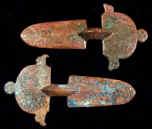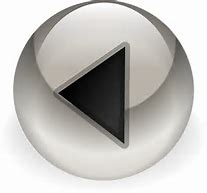







Looking After Your Finds - Reference




Germanic Finds - Hunnish, Ostrogothic, Frankish


Powered By Sispro1

1. EASTERN GERMANIC GOLD FIBULAE - IV century A.D.
Sheet silver plates of rhomboid shape covered in gold sheet and then bent
around the edges of silver for attachment. Collars varying in shape, each containing an irregular almandine are soldered to the gold plate and arranged symmetrically. Double-beaded boarder along the perimeter. At the rear: pin with spring mechanism and catch, in this example, pin missing from one fibula. Surface is covered with products of oxidation of copper, which was part of silver alloy. L. 1.4"(3.6 cm).
Sheet silver plates of rhomboid shape covered in gold sheet and then bent
around the edges of silver for attachment. Collars varying in shape, each containing an irregular almandine are soldered to the gold plate and arranged symmetrically. Double-beaded boarder along the perimeter. At the rear: pin with spring mechanism and catch, in this example, pin missing from one fibula. Surface is covered with products of oxidation of copper, which was part of silver alloy. L. 1.4"(3.6 cm).
2. EASTERN GERMANIC BRONZE FIBULA - SECOND HALF OF V century A.D.DANUBE region
Cast bronze, Kerbschnitt (or Keil) technique, where patterns of pyramids were deeply cast and worked over with a chisel. Radiate head with central knob. Narrow arched bow; lozenge shaped foot with animal head at the toe. At the rear: oxidized iron chunk (iron spring) with fragment of original fabric, in this example, missing pin.
L. 2.6"(6.6 cm).
Cast bronze, Kerbschnitt (or Keil) technique, where patterns of pyramids were deeply cast and worked over with a chisel. Radiate head with central knob. Narrow arched bow; lozenge shaped foot with animal head at the toe. At the rear: oxidized iron chunk (iron spring) with fragment of original fabric, in this example, missing pin.
L. 2.6"(6.6 cm).
3. EASTERN GERMANIC BRONZE FIBULA - SECOND HALF OF V century A.D. DANUBE region
Cast bronze, Kerbschnitt (or Keil) technique, where patterns of pyramids were deeply cast and worked over with a chisel. Radiate head with grooved central knob. Narrow arched bow flanked by lateral grooves; lozenge shaped foot with animal head at the toe. At the rear: central lug with oxidized iron chunk (iron spring) with catch at footplate; in this example the pin is missing. L. 2.6"(6.6 cm).
Cast bronze, Kerbschnitt (or Keil) technique, where patterns of pyramids were deeply cast and worked over with a chisel. Radiate head with grooved central knob. Narrow arched bow flanked by lateral grooves; lozenge shaped foot with animal head at the toe. At the rear: central lug with oxidized iron chunk (iron spring) with catch at footplate; in this example the pin is missing. L. 2.6"(6.6 cm).
4. GERMANIC BRONZE FIBULA - V century A.D.
Cast. Half-circle headplate with spoked grooves and five projecting knobs. Arched bow with pronounced central ridge, long pointed footplate decorated with grooves. At the rear is a lug, axis bar and spring, all bronze. Irregularly formed bronze pin, in this example, the catch is missing. L. 3.3" (8.4 cm).
Cast. Half-circle headplate with spoked grooves and five projecting knobs. Arched bow with pronounced central ridge, long pointed footplate decorated with grooves. At the rear is a lug, axis bar and spring, all bronze. Irregularly formed bronze pin, in this example, the catch is missing. L. 3.3" (8.4 cm).
5. GERMANIC SILVER FIBULA - FIRST HALF OF VI century A.D.
Cast, gilt silver, chip-carving technique. Semi-circular head plate with three projecting knobs and scrolling decoration; arching bow with two wide grooves; foot with lozenge shaped decorations gradually decreasing in size, central projecting toe and two garnet inlays. Flat underside with preserved pin and spring mechanism, catch at footplate.1.5 x 2.8 inches.
Cast, gilt silver, chip-carving technique. Semi-circular head plate with three projecting knobs and scrolling decoration; arching bow with two wide grooves; foot with lozenge shaped decorations gradually decreasing in size, central projecting toe and two garnet inlays. Flat underside with preserved pin and spring mechanism, catch at footplate.1.5 x 2.8 inches.
6. GEPIDIC SILVER FIBULAE VI century A.D.
Done in Kerbschnitt (or Keil) technique, where patterns of scrolling were deeply cast and worked over with a chisel. Radiate head with three knobs, each set with a garnet cabochon; deep spiral decoration in between; narrow arched bow with pronounced central ridge and garnet cabochon in the middle; lozenge shaped foot with two projecting birds' heads, set with cabochon garnets, deep spiral decoration in between; concentric circles at the toe. At the rear: two lugs with an axis bar, spring, pin and catch. L. 3.9" (9.9 cm).
Done in Kerbschnitt (or Keil) technique, where patterns of scrolling were deeply cast and worked over with a chisel. Radiate head with three knobs, each set with a garnet cabochon; deep spiral decoration in between; narrow arched bow with pronounced central ridge and garnet cabochon in the middle; lozenge shaped foot with two projecting birds' heads, set with cabochon garnets, deep spiral decoration in between; concentric circles at the toe. At the rear: two lugs with an axis bar, spring, pin and catch. L. 3.9" (9.9 cm).




7. A PAIR OF GERMANIC GILT SILVER FIBULAE - SECOND HALF OF V -
FIRST HALF OF VI century A.D.
Cast, gilt silver, Kerbschnitt (or Keil) technique, where patterns of scrolling were deeply cast and worked over with a chisel. Gilt radiate head with five knobs and deep spiral decoration; narrow arched bow with pronounced central ridge; gilt lozenge shaped foot with two knobs set with garnet cabochons, deep spiral decoration in between; animal head at the toe. At the rear: two widely spaced lugs, an axis bar, oxidized iron chunk (iron spring). In this example, missing pins on both fibulae, with original garnets. L. 3.9"(9.9 cm).
FIRST HALF OF VI century A.D.
Cast, gilt silver, Kerbschnitt (or Keil) technique, where patterns of scrolling were deeply cast and worked over with a chisel. Gilt radiate head with five knobs and deep spiral decoration; narrow arched bow with pronounced central ridge; gilt lozenge shaped foot with two knobs set with garnet cabochons, deep spiral decoration in between; animal head at the toe. At the rear: two widely spaced lugs, an axis bar, oxidized iron chunk (iron spring). In this example, missing pins on both fibulae, with original garnets. L. 3.9"(9.9 cm).
8. EASTERN GERMANIC GILT SILVER FIBULAE - FIRST HALF OF VI century A.D.
Cast, gilt silver, Kerbschnitt (or Keil) technique, where patterns of scrolling were deeply cast and worked over with a chisel. Gilt radiate head with five knobs, central knob inlaid with a garnet cabochon; deep spiral decoration; arched bow with pronounced central ridge. The rhomboidal footplate has four garnet cabochons at the corners, the two lower ones in the form of the heads of stylized birds, the perforation was drilled. Animal head at the toe. At the rear: two widely spaced lugs, an axis bar, spring. In this example, missing pins on both fibulae, otherwise intact, with original garnets. L. 4.7"(12 cm).
Cast, gilt silver, Kerbschnitt (or Keil) technique, where patterns of scrolling were deeply cast and worked over with a chisel. Gilt radiate head with five knobs, central knob inlaid with a garnet cabochon; deep spiral decoration; arched bow with pronounced central ridge. The rhomboidal footplate has four garnet cabochons at the corners, the two lower ones in the form of the heads of stylized birds, the perforation was drilled. Animal head at the toe. At the rear: two widely spaced lugs, an axis bar, spring. In this example, missing pins on both fibulae, otherwise intact, with original garnets. L. 4.7"(12 cm).



9. PAIR OF GERMANIC BRONZE FIBULAE - FIRST HALF OF V century A.D. - DANUBE region
Flat half-circle headplate, arching bow; multi-angular, pointed, flat footplate. Spring mechanism, pin and the catch have not survived. L. 2.8" (7.1 cm).
Flat half-circle headplate, arching bow; multi-angular, pointed, flat footplate. Spring mechanism, pin and the catch have not survived. L. 2.8" (7.1 cm).

10. GERMANIC SILVER FIBULA - FIRST HALF OF V century A.D. - DANUBE region
Flat half-circle headplate, arching bow with pronounced ridge; triangular shaped footplate with light ridge and rounded corners. Headplate decorated with small projection at the top and incised lines at the flanks. Upper part of footplate also decorated with incised lines, forming triangle. Preserved spring mechanism, however, pin missing in this example; catch at footplate. L. 3.8" (9.7 cm).
Flat half-circle headplate, arching bow with pronounced ridge; triangular shaped footplate with light ridge and rounded corners. Headplate decorated with small projection at the top and incised lines at the flanks. Upper part of footplate also decorated with incised lines, forming triangle. Preserved spring mechanism, however, pin missing in this example; catch at footplate. L. 3.8" (9.7 cm).

11. PAIR OF VISIGOTHIC BRONZE FIBULAE - VI century A.D.
Cast. Flat half-circle headplate, pronounced bow with sharp central ridge, long pointed footplate with light ridge. Headplate decorated with a disc and projecting birds' heads at opposition, the eye of each being marked with a ring and dot. Flat underside with preserved spring mechanism; catch at footplate; pins partially missing. One bird's head on each fibula mended. L. 3.6" (9.1 cm).
Cast. Flat half-circle headplate, pronounced bow with sharp central ridge, long pointed footplate with light ridge. Headplate decorated with a disc and projecting birds' heads at opposition, the eye of each being marked with a ring and dot. Flat underside with preserved spring mechanism; catch at footplate; pins partially missing. One bird's head on each fibula mended. L. 3.6" (9.1 cm).

12. VISIGOTHIC BRONZE FIBULA - VI century A.D.
Cast. Flat half-circle headplate, pronounced bow; long, flat footplate. Headplate decorated with three projecting discs. Flat underside with preserved spring mechanism, again, like many of these finds the pin missing. L. 3.7" (9.4 cm).
Cast. Flat half-circle headplate, pronounced bow; long, flat footplate. Headplate decorated with three projecting discs. Flat underside with preserved spring mechanism, again, like many of these finds the pin missing. L. 3.7" (9.4 cm).

Copyright All Rights Reserved by Nigel G Wilcox E-Mail: ngwilcox100@gmail.com
Complimentary Topics
Designed by Nigel G Wilcox
The Paragon Of Metal Detecting
& Archaeology
& Archaeology
For More >>>
For More >>>
Pages
Anglo-Saxon Menu
Anglo-Saxon Menu
Main Coin Menu

Anglo-Saxon Coins
Member NCMD
Anglo-Saxon Menu























